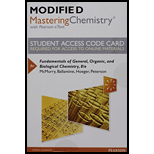
Concept explainers
Interpretation:
To code for preproinsulin, the number of heterocyclic bases present in the informational DNA strand has to be predicted.
Concept Introduction:
RNA synthesis: The process of RNA synthesis is Transcription. A small section of DNA unwinds, only one of the two strands act as template and the other strand as informational strand. The complementary bases are attached one by one by the action of RNA polymerase at template strand on moving down. The newly generated RNA is the exact copy of the informational strand, with the exception that a U replaces each T in the template DNA. The RNA synthesised carries genetic information and directs protein synthesis.
Codon: A sequence of three ribonucleotides in the mRNA chain that codes for a specific amino acid; also a three-
Nucleic acid: A complex organic substance present in living cell, which is a long polynucleotides. RNA and DNA are the two types of
Genetic code: The sequence of nucleotides, coded in triplets (codons) in mRNA that determines the sequence of amino acids in protein synthesis.
Want to see the full answer?
Check out a sample textbook solution
Chapter 26 Solutions
Modified Mastering Chemistry With Pearson Etext -- Standalone Access Card -- For Fundamentals Of General, Organic, And Biological Chemistry (8th Edition)
- If an extra nucleotide is inserted in the first exon of the beta globin gene, what effect will it have on the amino acid sequence of the globin polypeptides? Will the globin most likely be fully functional, partly functional, or nonfunctional? Why?arrow_forwardIf the genetic code used 4 bases at a time, how many amino acids could be encoded?arrow_forwardWhat part(s) of a nucleotide (namely, phosphate, sugar, and/or base) is/are found in the major and minor grooves of double-stranded DNA, and what part(s) is/are found in the DNA backbone? If a DNA-binding protein does not recognize a specific nucleotide sequence, do you expect that it binds tothe major groove, the minor groove, or the DNA backbone? Explain.arrow_forward
- The template strand of a double helical segment of DNA consists of the following sequence: 5’-GTAGCCTTAAGCGATCACCGTCCGTATTACTAGTGGCCAGACTCTTTTCACTCTCATGTATAGTTG-3’ What is the nucleotide order in the complementary DNA strand?arrow_forwardIn eukaryotic cells, the length of the transcribed RNA is almost equal to the corresponding DNA strand. True or false?arrow_forwardIf a polyribonucleotide contains equal amounts ofrandomly positioned adenine and uracil bases, what proportion of its triplets will encode (a) phenylalanine, (b)isoleucine, (c) leucine, (d) tyrosine?arrow_forward
- The double helical structure of DNA is intrinsically unstable and easily dissociates to form two separate strands. Why? How does this affect the two key biological functions of chromosomal DNA? What would happen if the DNA helices were too stable?arrow_forwardFor a DNA template strand containing the sequence 3'AATTGGCC 5', what is the sequence of nucleotides from the 5' to the 3' end in the mRNA transcript?arrow_forwardIn the following sequence, a cytosine was deaminated and is now a uracil (underlined). 5’-GGTAUTAAGC-3’ a. Which repair pathway(s) could restore this uracil to cytosine? b. If the uracil is not removed before a DNA replication fork passes through, what will be the sequences of the two resulting double helices? Provide the sequences of both strands of both helices. Label the old and new strands and underline the mutation(s). c. Could the mismatch repair pathway fix the mutations you’ve indicated in part b? d. If the cell undergoes mitosis, and the replicated DNAs are distributed into the two daughter cells. Will 0, 1, or 2 daughter cells have a mutation in this sequence?arrow_forward
 Human Heredity: Principles and Issues (MindTap Co...BiologyISBN:9781305251052Author:Michael CummingsPublisher:Cengage Learning
Human Heredity: Principles and Issues (MindTap Co...BiologyISBN:9781305251052Author:Michael CummingsPublisher:Cengage Learning
